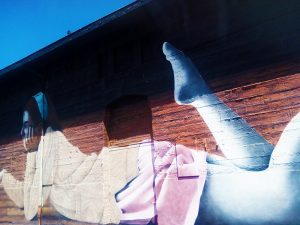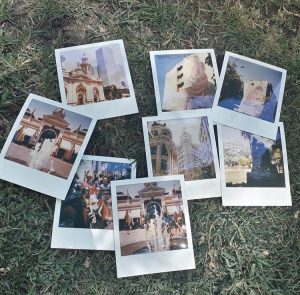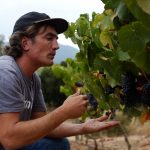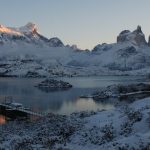Imagine taking in a city with your own two eyes. The art, the history, the quirky corners and unexpected sights.
Instead of taking dozens of digital photos that will never see the light of day, think about picking up a vintage Polaroid camera and consider carefully which few moments you’d like to remember. What would you choose? To pose yourself near a wall, and ask someone else to snap, or take the camera into your own hands and photograph something unusual, the way the light hits the leaves on a tree or one of your new favorite murals, piles of antiques, or hand-lettered signs? Handle the camera with care, click and whir and pull, and wait as the colors develop in your instant photo, harkening back to physical photo albums and bulletin boards and family keepsakes, to days of postcards and memories you could hold in your own two hands.
 These are some of the things that go through my mind as I’m on tour with Rubén Riquelme from Puelmapu Turismo Sustentable and Camilo Bahamondes from Instant Tours in Santiago’s Franklin neighborhood. We start the day standing before a mural in Santiago’s brand new Bío Bío metro, which sets the stage for what we’ll learn during the tour about the history and current happenings in this iconic Santiago neighborhood.
These are some of the things that go through my mind as I’m on tour with Rubén Riquelme from Puelmapu Turismo Sustentable and Camilo Bahamondes from Instant Tours in Santiago’s Franklin neighborhood. We start the day standing before a mural in Santiago’s brand new Bío Bío metro, which sets the stage for what we’ll learn during the tour about the history and current happenings in this iconic Santiago neighborhood.
It all started with the relocation of the city’s abattoir from the core of the city closer to what was then the outer edge of the city, local on a waterway necessary for the matadero to function smoothly. Dating back to that important relocation in 1847, a community formed around this important source of work, and over time, a patchwork of immigrants, workers and artists found their way to this area, which have contributed to make it what it is today. This neighborhood has been a center of important economic activity since the mid 1800s, when the matadero first opened, and while those operations have since been relocated, much of the important architecture still stands, including housing dating back to the early 1900s in the nearby area called Barrio Huemul, in what is held to be one of the city’s first satellite neighborhoods, complete with a hospital, theater and central square.
As we walked out of the metro via the Franklin exit, our expert guides explained the importance of this mixed-use area that combines commerce and housing, and has been the home to many storied Chilean artists and musicians, including Pedro Lemebel, an iconoclastic gay essayist/novelist who grew up here. We continued on, approaching the outskirts of what is known as “El Persa,” which in Chilean Spanish refers to a flea market. The beginning of this area has stalls set up on the street, where people sell t-shirts, electronics, food and other assorted merchandise. Here we stopped to talk to a local, who explained a more about how the neighborhood formed, the different parts of it, and how together they have woven their cultural identity in Franklin, with citizen groups to help manage changes, and even a radio station.
From here we moved on to the different galpones or indoor hangars, which house aisles and aisles of pretty much anything imaginable, from places to get your hair cut, to traditional Chilean cuisine, and international food, woodcut prints from palm-sized to life-sized, to stalls selling vintage clothes. The neighborhood is the perfect definition of a city-within-a-city, with streets and alleys that each specialize in a different type of commerce. We stopped for a few minutes at El Pirata to try kuchen, a German-influenced fruit pastry, and also a cake with manjar, Chile’s version of dulce de leche. We continued on to different parts of the neighborhood, including the open market, behind a large, pale pink archway where locals come to buy fresh fruits and vegetables.
Later on, we headed to one of the more established restaurants, El Tata to talk to the owner about the history of Chilean pipeño, a “green” wine, which here we drink together with canned peaches and the Argentine spirit Fernet. Pipeño by itself can be a bit hard to drink, and this combination, in addition to making it sweeter, is a bit of a nod to the Chilean drink called terremoto, which is popular at traditional watering holes and throughout the country in mid-September, when the Chilean national holiday (fiestas patrias) takes place.
 We continue on through the persa, past stalls with old typewriters and wooden hormas (lasts, or models used by shoemakers), and all manner of crockery and enameled pots, and here people start to make use of the vintage cameras, taking photos of antiques, and each other, deliberately pressing down on the shutter only when they are positively convinced that those are the memories they want to keep.
We continue on through the persa, past stalls with old typewriters and wooden hormas (lasts, or models used by shoemakers), and all manner of crockery and enameled pots, and here people start to make use of the vintage cameras, taking photos of antiques, and each other, deliberately pressing down on the shutter only when they are positively convinced that those are the memories they want to keep.
It’s hard to rewire the desire to reach, almost without thought, to our cellphones, to capture these moments of double nostalgia, for the antiques and the old school cameras. Many of us take digital photos of this day because though we have made a trip back in time to this neighborhood and with these old cameras, we are, after all, products of the modern age. And the urge to share this moment immediately with friends and family back home is too strong for some of us to ignore.
Puelmapu runs tours of Franklin and has a few more tours in the works, including a poetry-based one out on the coast. Instant Tours runs the Franklin tours in tandem with Puelmapu and also does tours of downtown Santiago and Lastarria, itself a study of changing urban landscapes with murals and winding cobblestone streets. They also do a tour of the open-air mural museum in San Miguel and have recently added a tour in Valparaíso. All of these tours include use of the Polaroid, and a pack of film, or participants can opt to use their own cameras and forego the Polaroids, though we recommend getting the full experience and having the souvenirs to remember the day by.

